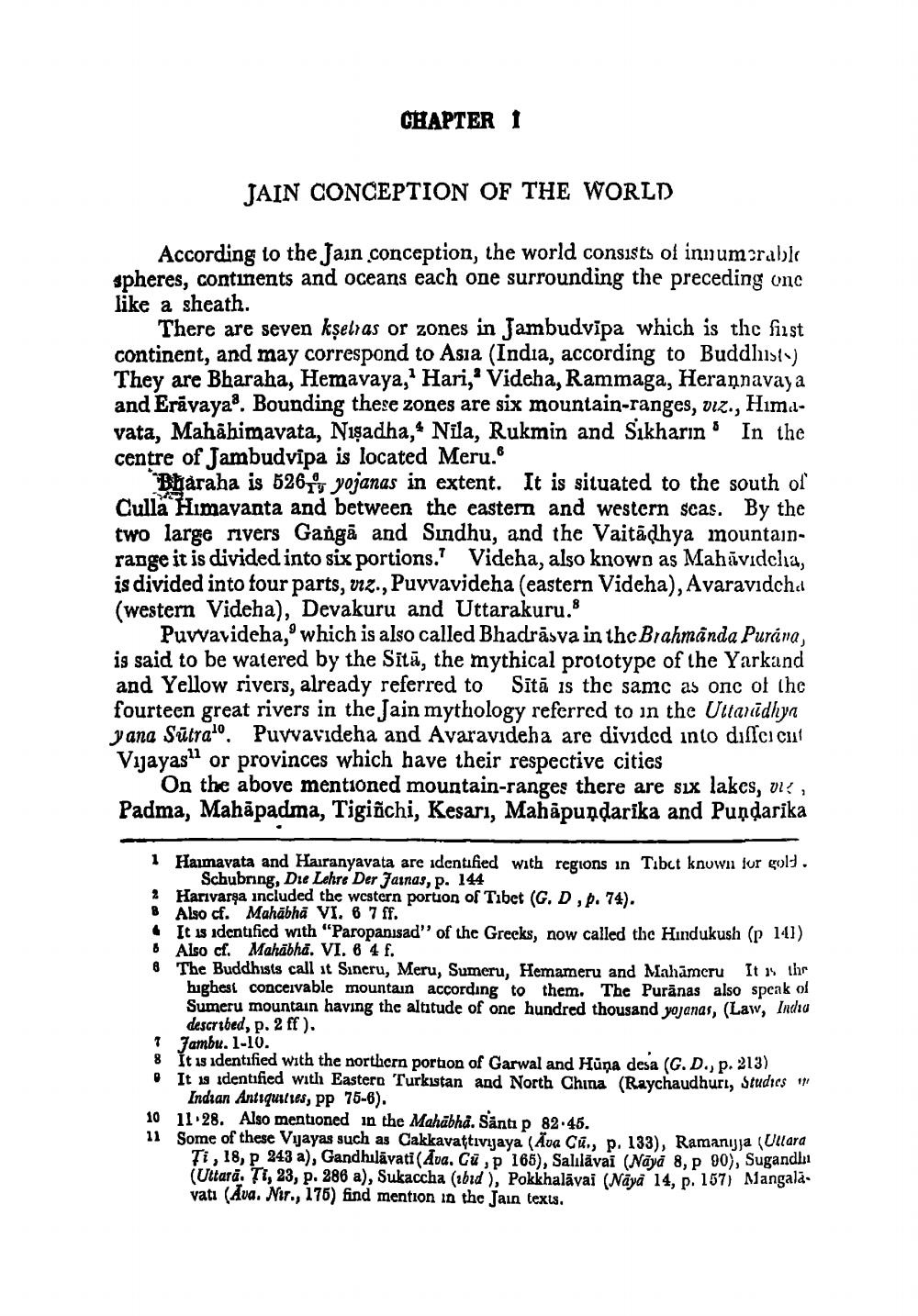________________
CHAPTER 1
JAIN CONCEPTION OF THE WORLD
According to the Jain conception, the world consists of inijumorable spheres, continents and oceans each one surrounding the preceding onc like a sheath.
There are seven kşelias or zones in Jambudvipa which is the first continent, and may correspond to Asia (India, according to Buddhist They are Bharaha, Hemavaya," Hari,' Videha, Rammaga, Herannavaya and Erävaya. Bounding these zones are six mountain-ranges, viz., Him.ivata, Mahāhimavata, Nişadha, Nila, Rukmin and Sikharin: In the centre of Jambudvipa is located Meru.
"Bharaha is 526,9 yojanas in extent. It is situated to the south of Culla Himayanta and between the eastern and western scas. By the two large rivers Gangā and Sundhu, and the Vaitadhya mountainrange it is divided into six portions. Videha, also known as Mahavidchia, is divided into four parts, viz., Puyvavideha (eastern Videha), Avaravidcha (western Videha), Devakuru and Uttarakuru.
Puvvavideha, which is also called Bhadrāsya in thc Brahmanda Purana, is said to be watered by the Sītā, the mythical prototype of the Yarkand and Yellow rivers, already referred to Sītā is the same as one of the fourteen great rivers in the Jain mythology referred to in the Ultanidhya yana Sutra". Puvvavideha and Avaravıdeha are divided into difici cut Vijayas or provinces which have their respective cities
On the above mentioned mountain-ranges there are six lakes, 01?, Padma, Mahāpadma, Tigiñchi, Kesarı, Mahapundarika and Pundarika
1 Haimavata and Hairanyavata are identified with regions in Tibct known for gold.
Schubring, Die Lehre Der Fainas, p. 144 2 Harivarsa included the western portion of Tibet (
G D , p. 74). 8 Also cf. Mahābhā VI. 6 7 ff. • It is identified with "Paropanısad" of the Greeks, now called the Hindukush (p 141) 6 Also cf. Mahābhā. VI. 6 4 f. 8 The Buddhists call it Sincru, Meru, Sumeru, Hemameru and Mahameru Its thr
highest conceivable mountain according to them. The Purānas also speak ol Sumeru mountain having the altitude of one hundred thousand yojanas, (Law, Indiu
described, p. 2 ff). 1 Jambu. 1-10. 8 It is identified with the northern portion of Garwal and Huna desa (G.D., p. 213) • It is identified with Eastern Turkistan and North China (Raychaudhuri, Studies *
Indian Antiquiries, pp 75-6). 10 11.28. Also mentioned in the Mahābha. Santi p 82.45. 11 Some of these Vijayas such as Cakkavattivijaya (Ava Cu., p. 133), Ramanija (Ullara
Ti , 18, p 243 a), Gandhilāvati (Ava. Gu, p165), Salılävai (Nāya 8, P 90), Sugandhi (Uttara. TT, 23, p. 286 a), Sukaccha (ibid), Pokkhalāvai (Näyå 14, p. 157) Mangald. vati (Ava. Nir., 176) find mention in the Jain texts.




